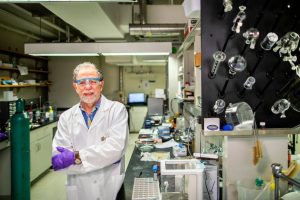
Check out our second seminar this spring featuring Dr. Thomas Mallouk from the Department of Chemistry at the University of Pennsylvania. He will speak in Maryland Hall room 110 on Wednesday, January 31st from 3 – 3:50pm.
Managing Electrons and Protons in Solar and Electrochemical Energy Conversion
Future solar energy conversion and storage systems must be efficient, stable, and inexpensive in order to be competitive with fossil energy sources. In biological photosynthesis, the internal quantum efficiency for light-induced charge separation is near unity, and the balance of pH across the thylakoid membrane is maintained by coupling a trans-membrane proton concentration gradient to ATP synthesis. In artificial photosynthetic systems, such as buffer-based water splitting cells, the generation of acid at the anode and base at the cathode results in similar pH gradients, but they are uncompensated. Losses from electrochemically generated pH gradients become substantial in cells that run continuously for periods of hours. We found that this problem can be solved by using bipolar membrane-based cells in which the cathode and anode operate at low and high pH, respectively. Bipolar membranes enable efficient solar water splitting and CO2 electrolysis, and also have advantages for other membrane-based electrochemical devices such as fuel cells, redox flow batteries, and CO2 ocean capture systems. The catalytic reaction enabling all these applications is water association/dissociation at the bipolar polymer interface, which is still not fully understood or optimized.
A related problem with both monopolar and bipolar membrane electrochemical systems is the thermal dehydration and chemical degradation of polymeric alkaline membranes. Stable, CO2-tolerant hydroxide ion conductors are needed to enable the use of earth-abundant, non-precious metal electrocatalysts in alkaline electrochemical systems. This talk will describe our progress in determining the mechanism of hydroxide ion conductivity in layered double hydroxides, which are stable in electrochemical environments and are promising membrane materials for alkaline fuel cells and electrolyzers.
ABout the speaker
Thomas E. Mallouk received his bachelor’s degree from Brown University, where he did undergraduate research with Aaron Wold, and was a Ph.D. student with Neil Bartlett at the University of California, Berkeley. Prior to moving to Penn in 2019, he held faculty positions at the University of Texas at Austin and at Penn State University. He is currently Vagelos Professor in Energy Research in the Department of Chemistry at the University of Pennsylvania. His research focuses on the synthesis of inorganic materials and their application to solar energy conversion, catalysis and electrocatalysis, nano- and microscale robotics, low dimensional physical phenomena, and critical element separations. He is the author of 400+ publications, including a few good ones, and a member of the U.S. National Academy of Sciences.